
12 minute read
EPIROC IN BRIEF
HISTORIC BATTERYELECTRIC FIELD TEST IN SWEDEN
Skanska Industrial Solutions AB is trialling a new rig from Epiroc: the first ever tophammer batteryelectric rig in Sweden. The design of the rig is based on the well-proven SmartROC T35 surface drill rig. In combination with invaluable experience gained from the development of Epiroc underground battery rigs, this SmartROC T35 E is designed to enhance the environmental standards of quarries and larger construction sites. Besides low emissions, this rig comes with a range of smart features, options and enhanced automation solutions for high safety, reliability and performance.
Advertisement
“With this achievement, we show that the innovations of Epiroc will play a significant role in the shift to low-carbon operations in quarries and large construction applications,” says Jose M. Sanchez, President Epiroc Surface division. “Since our sustainability agenda goes hand in hand with the agendas of our customers, we are very pleased to be collaborating with Skanska Industrial Solutions AB in the trials of this important solution.”
The tests commenced in early October in one of Skanska Industrial Solution’s quarries in the Stockholm area:
“A milestone has been reached, and a new opportunity has come to reduce our climate impact. I am very happy about the long collaboration between Epiroc and Skanska, and it is exciting to be able to do this project together. Both companies have set bold environmental goals – this project really takes a great step toward Skanska’s goal of be-
SmartROC T35 E
The SmartROC T35 E rig is equipped with both a battery and an electric cable, which improves flexibility considerably. You can choose to drill with the most suitable alternative for the location and occasion. It also allows for quick and smooth transportation in and between sites.
ALEXANDER VON SYDOW
The SmartROC T35 E is being trialled by Skanska in the Stockholm area. The rig is an important step in the shift toward zero-emission drilling in surface mines and quarries all over the world.
ing completely climate neutral by 2045, which is an important part of our promise to build a better society,” says Johan Eliasson, Project Manager, Skanska Industrial Solutions AB.
The SmartROC T35 E is fitted with the same type of well-proven batteries and subcomponents as are in the Epiroc underground battery solutions. This streamlines spare parts handling and service for customers with several different operations.
Epiroc and BluVein speed up industry shift Epiroc acquires mining electrification infrastructure provider JTMEC
ELECTRIFICATION SOLUTIONS
from Epiroc support mining customers in their transformation towards using battery electric vehicles. To further strengthen this approach, Epiroc has formed a Memorandum of Understanding with BluVein, a joint venture between Australian mining innovator Olitek and Swedish electric highways developer Evias. The purpose is to fast-track development of the BluVein dynamic charging solution toward an industrialized and robust solution for the global mining industry.
EPIROC HAS ACQUIRED Australian company JTMEC, an electrification infrastructure solutions provider for both underground and surface mines. The company’s offerings include high voltage installation and maintenance work, transformer servicing and testing, engineering design, feasibility studies, and training. It also manufactures electrical products, including substations and mine chargers. JTMEC is based in Perth and employs 190 people.
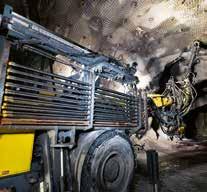
Boltec Auto Bolt Reload redefines safety and productivity
EPIROC’S NEW Boltec with Auto
Bolt Reload (ABR) is the first- ever underground rock reinforcement drill rig designed so that the bolt type and machine work together in synergy to deliver optimal safety, performance and quality. The main design feature of the Boltec ABR is the fully mechanized bolt reloading system, which automatically feeds bolts from a large carrier magazine to the feed magazine.
FIGURE
10 DAYS
DRILLING TOOLS OPTIMIZER is Epiroc’s new digital toolbox packed with benefits for everyone. It provides a new level of knowledge, accuracy and business opportunities, following drilling tools throughout their entire product life cycles from new to end-of-life. Drilling Tools Optimizer enables productioncritical decisions in real time, which can save up to ten workdays per month related to data gathering.
PROJECT NEWS
HIGHLIGHT
Motivator does not rely on electrical infrastructure, thus enabling continuous and more agile operations.
More agile operations with Motivator

TO INCREASE utilization and overall productivity of environmentally friendly electric driven Epiroc rotary drills, Epiroc has developed a self-contained, wagon-mounted hydraulic powerpack to operate select rig functions in the absence of electric power. The basic unit will propel the unit via radio remote control from bench to bench, pit to pit or shop without the time and expense of installing electrical infrastructure along the route. Product news and innovation stories (choose country and click Newsroom): epiroc.com Epiroc corporate press releases (click Media): epirocgroup.com
Circular economy models revolve around using existing materials and products as long as possible – in different ways.
How can Epiroc contribute to circularity?
Lucia Canedo
Surface division SHEQ Manager
“Epiroc can contribute to circularity by reducing waste and CO2 emissions generated throughout our value chain. Our 2030 sustainability goals for the planet – to halve CO2 emissions in operations, transport, relevant suppliers and from our machines sold – is driving our circularity journey.”
Matthew McCarthy
Global Sustainability Booster
“Ambitious targets for waste diversion drive circularity in our design, sales, sourcing and production phases. Embedding circularity in our processes is challenging, but it will reduce our environmental footprint and support customer circularity goals.”
Effort Moyo
Global Product Manager
“Circularity is a key criteria when we create and package aftermarket products today. We innovate products and services that prolong the product life of our equipment, and we remanufacture, rebuild, reuse and recycle components when necessary and possible.”

[ On Location ] Peru
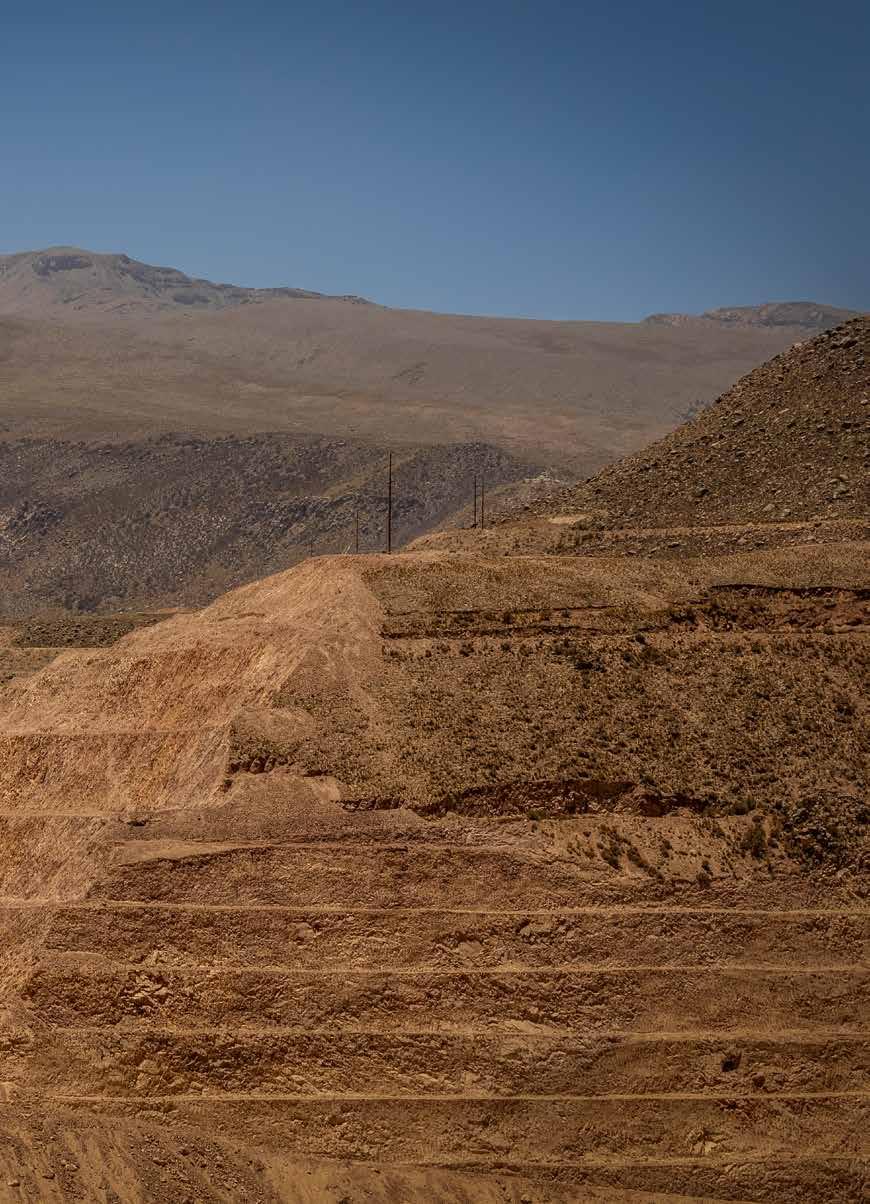
QUELLAVECO MINE Anglo y s the future
High in the arid mountains of southern Peru, Anglo American is taking the next step in mining: a giant new copper mine operated largely by robots.
From the comfort of the integrated operations center, Karen Huamantuma monitors the operations of two Epiroc autonomous Pit Viper rigs in the Quellaveco mine.
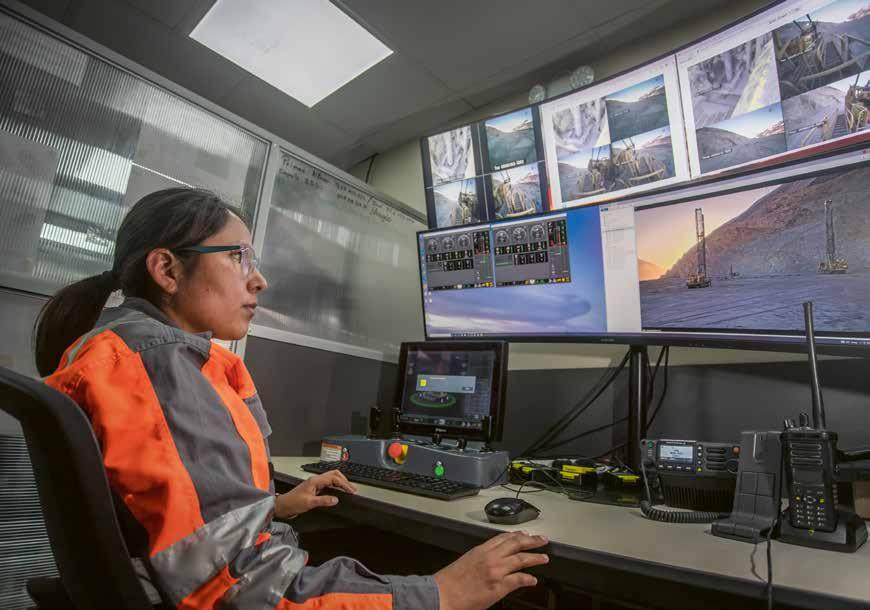
ON A DUSTY MINE ROAD high in the Andes Mountains, a monstrous truck the size of a house rumbles past with its load of 300 tons of ore. Glancing up through the blinding Andean sunlight, an observer struggles to catch a glimpse of the driver in the cabin. That’s because there isn’t one. Machines have taken over the mine.
At Quellaveco, Anglo American’s latest copper mine, the mining multinational is realizing a vision of what mining will look like in the future.
Built in Moquegua at a cost of approximately USD 5.5 billion, the mine is expected to produce annually around 300000 metric tons of copper (plus molybdenum) over the next decade, consolidating Peru’s position as the second-largest supplier of the red metal behind neighboring Chile.
One of the largest copper deposits on the planet, the new mine is expected to continue churning out metals for decades to come.
Following a preprogrammed route, twenty-eight driverless trucks patrol the pit, lining up to receive blasted ore or waste from the power shovel and then hauling it to either the primary crusher or the stockpiles. When they meet each other or another vehicle en route, they stop while they work out who has the right of way.
Epiroc is playing its part with six autonomous Pit Viper drill rigs. Standing almost twenty meters high when in position, the vehicles automatically trundle into place to drill a series of blastholes. Quellaveco is far from the first mine to introduce autonomous vehicles. From Australia to Chile, mining companies are racing to introduce new technologies into their operations, to improve productivity, safety and working conditions for employees. But Quellaveco will be the first greenfield mine project to implement the technology in its initial design.
Safety is one of the major gains of autonomous haulage and drilling. Not only are workers kept out of harm’s way, but the machines are programmed to be much more cautious than human operators would be.
Clayton Sanders
Head of Autonomous Drilling, Anglo American
“We’ve not had a single incident caused by an autonomous machine. And, in fact, the autonomous machines have prevented what may have been more serious incidents had they been conventionally operated,” says Clayton Sanders, Quellaveco’s head of Autonomous Drilling.
Autonomous vehicles have also proved more productive than conventional vehicles, maintaining a regular pace throughout the day. In addition, the Pit Viper rigs have proved more accurate than human operators, drilling all holes within 50 centimeters of the location specified in their preprogrammed drill pattern and to the specified length. Accuracy with conventional rigs can be more like 0.8–1.2 meters.
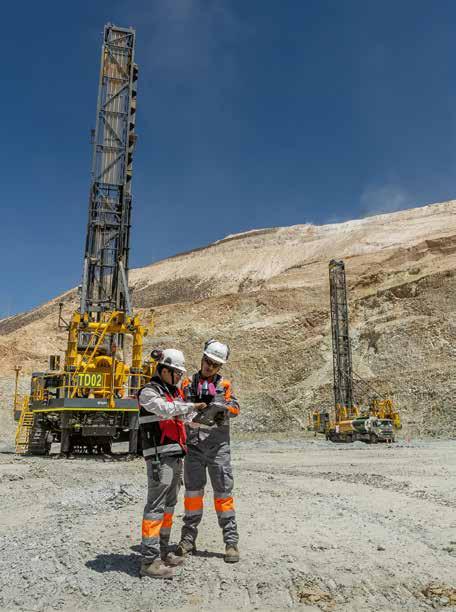
THIS PRECISION IS CRUCIAL for ensuring that explosives are properly distributed throughout the rock to obtain the correct fragmentation. This, in turn, facilitates the whole mining process, from how quickly rock can be shoveled and its safe distribution in the trucks to how efficiently it can be pummeled into powder in the crusher.
“This is critically important to the process,” explains Sanders.
But running a digital mine brings new challenges for Anglo American’s mine engineers. To stay in contact with dozens of autonomous vehicles while they move around the pit means ensuring that a sufficient broadband spectrum is available in all parts of the operation at all times. If contact is lost, the vehicle tends to grind to a halt until communication is restored.
As well as the mine’s mind-boggling topography, with mine fronts spread over several stories along a sinuous mountain ravine, a major challenge is the dust. Lifted in plumes by each gust of wind and passing vehicle, the fine powder quickly accumulates in a thick coat on every surface, including the dozens of sensors distributed throughout the mine.
So far, the quickest solution has been to send teams of technicians out
This is Anglo American
Headquartered
in London, Anglo
American is one of the world’s largest mining companies, with a market capitalization of around
USD 41 billion.
The company
was founded in 1917 with US and
British capital to finance gold mines in South
Africa.
Today it em-
ploys 90 000 people and produces coal, copper, iron ore and other minerals at 56 sites in 15 countries. Its subsidiary De Beers is the world’s largest producer of diamonds.
As part of its
Sustainable Mining Plan, the company has committed to reducing its greenhouse gas emissions by 30% and improving energy efficiency by 30% by the end of this decade.
Bryce Mancell Superintendent of Technology, Anglo American
Karen Huamantuma
Operator, Anglo American
Anglo American technicians Miguel Chuctaya and Dante Carhuas check the progress of two Pit Viper rigs at Quellaveco.
with brooms and cloths in an endless fight against the filth to keep the sensors sparkling. But because this runs counter to Quellaveco’s autonomous philosophy, the maintenance team is also working on an automated blower system that would keep the dust off around the clock.
Building a digital mine has also brought new opportunities. Given the different skills required to run autonomous haulage and drilling equipment, Anglo American has recruited many newcomers with no previous experience and trained them from scratch.
“Two-thirds of our workers never worked in mining before, which is very unique. Many did not even have a driver’s license before they joined us,” explained Bryce Mancell, Superintendent of Technology.
Bryce Mancell
Superintendent of Technology, Anglo American
Karen Huamantuma, a recent graduate in Mine Engineering from nearby National University of Moquegua, is one of the new recruits. Her fingers skim over the keyboard as she monitors two Pit Viper rigs drilling several hundred meters away. Above her head, a large screen indicates fuel and water levels for each machine and shows their progress through the sequences of holes they must bore.
“We never studied anything like this. I mean, we didn’t know it existed,” she says. Seated in an ergonomic office chair, she reckons the biggest gain has been the comfort and the convenience.
“We are not exposed to the dirt and dust or at risk from a rockfall or anything like that…this is more comfortable than being at home,” she explains.
Another gain has been the streamlining of decision-making. In a low hut on the edge of the mine sits Quellaveco’s mission control. Here, twenty or so engineers, like Huamantuma, huddle in front of long curved screens monitoring every aspect of the mine operation, from drilling and hauling to milling and shipping.
WITH ALL THE key players now in one room, identifying challenges and coordinating a response can take just a few minutes rather than half a day’s discussion. For example, if metal recoveries fall in the concentrator mill because of lower copper grades, a quick word from the plant operator to tthe mine planner is all it takes for the mine to begin extracting richer ore.
“We can see data trends before there’s a real issue and take corrective action before problems arise,” explains Mancell.
Epiroc and Anglo American
THE DEVELOPMENT OF the Quellaveco mine marks the start of Anglo American and Epiroc’s relationship in South America. In 2018, Epiroc won a contract to supply autonomous drill equipment to the mine, with deliveries beginning in March 2020. Despite the difficulties caused by the COVID-19 pandemic, six autonomous Pit Viper 351D drill rigs and three SmartROC D65 drill rigs were delivered and assembled at the mine by March 2022, in time for the start of production.
The Quellaveco mine
Anglo American, has called
Quellaveco, which it built at a cost of USD 5.5 billion, the world’s first fully digital greenfield mine project making full use of the latest technologies, including automation and renewable energy.
With reserves estimated at
1.7 billion metric tons, it is one of the world’s most important copper deposits.
Epiroc’s autonomous Pit Viper rigs drill blastholes much more precisely than conventionally operated drill rigs, ensuring the rock is properly fragmented and facilitating the whole mining operation.
FIVE KEYS TO SUCCESS
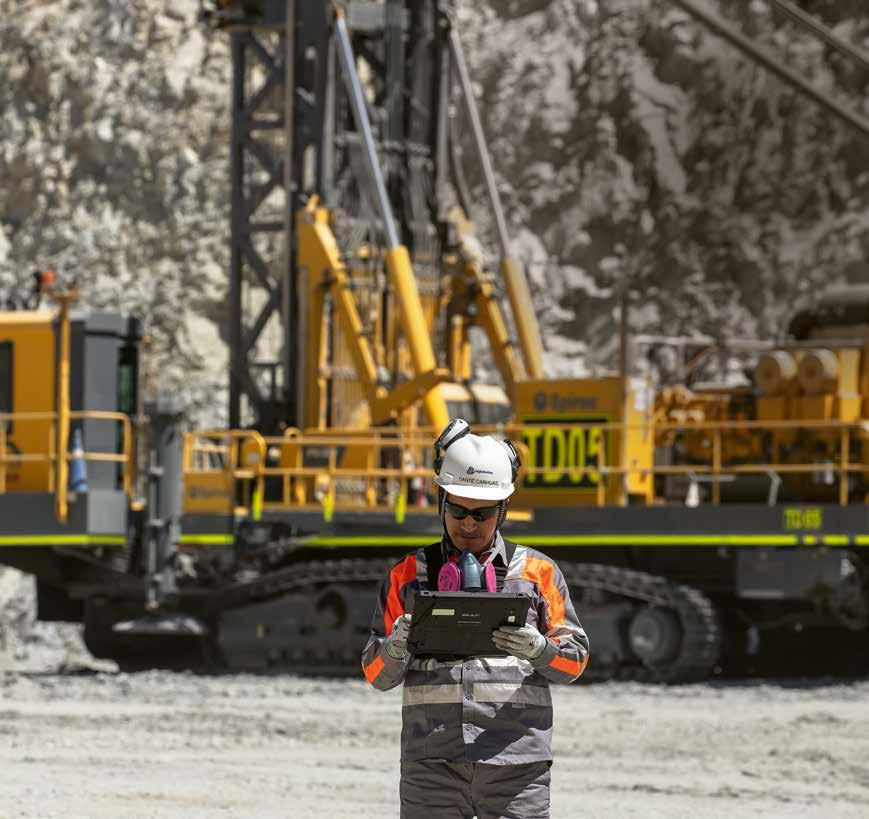
u The right technology
The autonomous Pit Viper 351 and SmartROC D65 drill rigs from Epiroc fit perfectly with Anglo American’s ambition to build the world’s first digital mine. v Tough enough
Anglo American has praised the robustness of Epiroc’s autonomous drilling system, which has meant that more than 90% of the holes at Quellaveco have been drilled autonomously despite challenging conditions. w Attention to detail
Thanks to the company’s experienced support staff, the drill rigs could be delivered and assembled at the mine site on schedule despite the remote location and the restrictions imposed by the COVID-19 pandemic. Training newcomers
Epiroc has helped Anglo American to train new employees with little or no experience in mining in the new role of rig controllers. Working hand in hand
Since the start of operations, engineers from Anglo American and Epiroc have worked in close collaboration to figure out how to improve the performance of the rigs while production ramps up to capacity.



